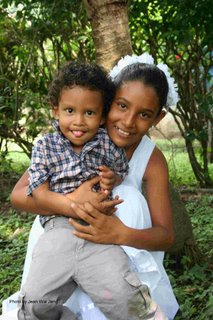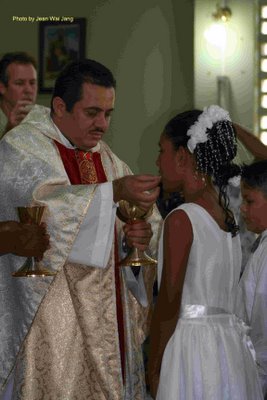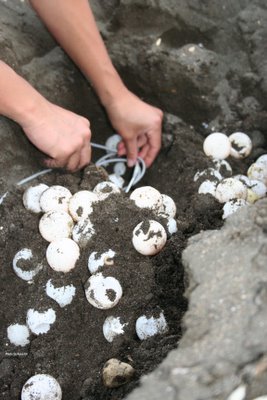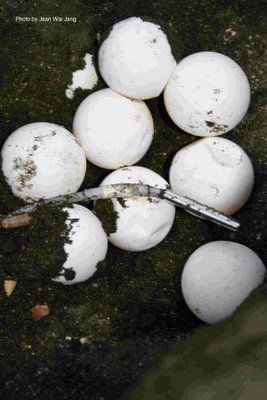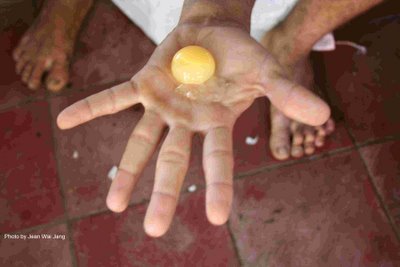Jean W. Jang
JeanJang@shaw.ca
Tuesday, November 29, 2005
Federico Bolañes - Universidad de Costa Rica

Federico is a professor at Universidad de Costa Rica. Although Ranas, frogs are his favorite, he has been helping me out. He can make a great rice dish from fresh coconut juice picked right by the station and loves rock and roll.
The station that I´m working out of belongs to the Universidad de Costa Rica. The project that I´m working on is a small part of the managment approach they are trying to implement with the Ministry of Environment and Energy MINAE, INCOPESCA (Instituto Costarricense de Pesca y Acuacultura /Costa Rican Fisheries and Aquaculture Institute), Universidad de Costa Rica, community of Ostional and ADIO The Association of Intergrated Development.
Tortuguita con dos cabezas!

Believe it or not an olive ridley sea turtle hatchling was found on the beach with two heads. It swims awkwardly all on one side and then the other, normally it would alternate between the left and right flippers.
When it was first discovered a man was running around town with it at 7am and there was a lot of hollering going on. With only 10 families in the pueblo it doesn´t take much for the whole town to find out about the new discovery. It was shown proudly to everyone that came through town. After a week it was released back into the sea. Quite the event, quite the sight.
The cutest boy on the beach!

Abraan is one of my favorites, at 4 years old he roams the beach freely all hours of the day, wandering around socializing. This photo was taken at 5am in the morning when Abraan appeared out of nowhere and decided to help us with our egg surveys. Often he likes to roll in the sand and pretend he´s a turtle building a nest. Imitating accurately he alternates his hind flippers, carving out the hole to drop eggs into. He wanted me to take photos of him with 1, 2 and then 3 eggs.
Yeah Volunteers!!!
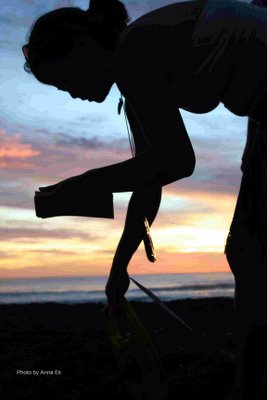
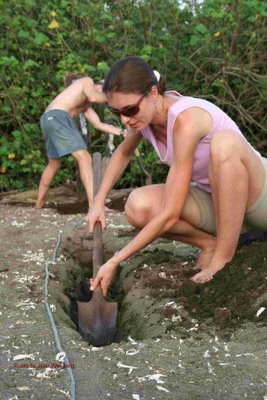
There has been people from all over the world helping with this project, Germany, Switzerland, Japan, USA and all over Costa Rica. I´m very grateful because with the hundreds of vultures on the beach there are a lot of eyes on me. The days on the beach are usually full of great conversations, followed by a swim and then a walk along the beach at sunset feeling satisfied the job is done. It never quite feels like work.
Placement of the ESI dataloggers

Setting the ESI temperature dataloggers wan´t an easy task for just one person. The vultures were crowding me hoping they would be able to steal some of the eggs I was digging up. Its difficult to explain to helpers that there are essentially eggs under the sand in the entire 7km stretch at Ostional. This photo shows eggs that were laid only a few days ago from the last arribada.
Environmental Sensors Victoria, BC Canada www.esica.com

 Environmental Sensors were used to measure the temperature of the soil substrate on the beach of Ostional. A main purpose of this project is to measure the difference in temperatures and hatching success of the turtles at estuary and non estuary sites.
Environmental Sensors were used to measure the temperature of the soil substrate on the beach of Ostional. A main purpose of this project is to measure the difference in temperatures and hatching success of the turtles at estuary and non estuary sites.The information retrieved from the dataloggers can be downloaded into different formats and is simple to use.
Thank you ESI for your contribution to this project!
Harvesting

The turtle eggs from the beach at Ostional are harvested locally. Harvesting only takes place the first 2 days of the arribada. Eggs are collected and sold to areas all over Costa Rica. Each family at Ostional can have up to 200 eggs for personal consumption. Eggs are also donated to various schools as food for children.
Zopilotes the Scavengers

Normally found in large flocks perched and flying overhead, these birds are known to scavenge for small and large sized animals. They will eat rotting animals and fight over it in large flocks. The bare head allows them to stick their head into a dead carcass without soiling feathers avoiding bacterial growth. Black vultures nest in early spring, laying their eggs in tree cavities, on rocky ledges, or in caves. Nesting locations are usually in remote areas and may be far from their feeding grounds.
Info Source: http://wildwnc.org/af/blackvulture.html
´Zopilotes´ Black Vultures (Coragyps atratus)
 Black vultures are commonly found at Ostional feasting on the turtle eggs and hatchlings. Due to the arribada the entire beach is filled with eggs under the sand. The zopilotes wait patiently besides dogs that dig up eggs to consume whatever is left over.
Black vultures are commonly found at Ostional feasting on the turtle eggs and hatchlings. Due to the arribada the entire beach is filled with eggs under the sand. The zopilotes wait patiently besides dogs that dig up eggs to consume whatever is left over.During the egg surveys the vultures are a little aggresive stealing eggs from behind you.
The zopilotes wing span is about 54 inches in length and both female and males look similar. They are found in southern USA, Central and South America.
Biology
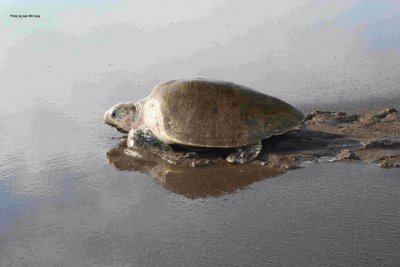
The olive ridley´s diet mostly consists of crabs, shrimp, rock lobsters, jellyfish and tunicates. Its also been reported that algae is its principle food source. Each female may lay 100-110 eggs per nest. The carapace in the Pacific are found to be 56-78 cm in length. Adults weigh from 77-100 pounds. They are typically found in coastal bays and estuaries.
Distribution

The range of the olive ridley is essentially tropical to warm temperature Pacific and Indian Oceans. They are also found in the Atlantic Ocean, the west coast of Africa and northeastern coast of South America. During unusually warm periods they may be found as far north as Alaska and south to New Zealand and Chile. They are not found in the Gulf of Mexico and in most of the North Atlantic Ocean.
Source: Sea Turtles by James R. Spotila
Arribada!

The olive ridley sea turtle commonly known as Lora in Costa Rica is the only one of the seven swimming turtles that lay their nests in an arribada. An arribada is when hundreds of turtles come up onto the beach to lay their eggs over a 4-6 day period. This is a predator prey saturation tactic that is used to allow the sucess of their young. Arribadas are also known as flotas in Costa Rica specifically.
´Lora´ Olive Ridley sea turtle (Lepidochelys olivacea) preferred nesting habitat at Ostional National Wildlife Refuge

This project is fully funded by ROYAL ROADS UNIVERSITY Victoria, BC Canada as the President’s Global Externship Field Studies Award
Through this award the Olive Ridley sea turtle (Lepidochelys olivacea) preferred nesting habitat: temperature and moisture of the substrate at Ostional National Wildlife Refuge Costa Rica will be researched.
Please contact me if you have any comments or questions at JeanJang@shaw.ca
© This website has a copyright. Any information or photographs used from this website requires permission from Jean Wai Jang.
